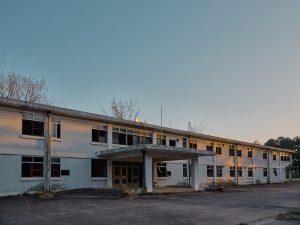Founded to commemorate the Gwangju Democratization Movement of 1980 and its lasting cultural influence, the Gwangju Biennale has established itself as one of the world’s leading contemporary art events since 1995. During the same period of the 13th edition of the Gwangju Biennale, the Gwangju Biennale Foundation presents the GB Commission and MaytoDay projects at the former Armed Forces’ Gwangju Hospital. Founded in the mid-1960s, the hospital is where students and civilians who were tortured during the May 18 Democratization Movement in 1980 were treated. Despite its designated status as one of the historic May 18 memorial sites, it has been left in ruins since the hospital relocated to Hampyeong in 2007, and it is due to turn into a national trauma centre. In this regard, the Foundation’s two ongoing projects acknowledge what may be the last opportunity for artists to engage with the site in its current state, recalling and imagining the hospital’s past, present, and future.
Gwangju Biennale Commission
In tandem with the Biennale’s founding statement, the GB Commission looks to shed light on the issues of sustainability and longevity, rather than limiting its scope to short-term assemblages, and understands that these are themes closely linked to art’s role in society at large.
GB Commission’s latest productions exhibited at the hospital include Minouk Lim’s Mr. Chai Eui Jin and 1,000 Canes (2014-20), a poignant installation that traces the perennial oeuvre of Chai Eui Jin, a survivor of a massacre that was committed against unarmed civilians just before the outbreak of the Korean War; Chiharu Shiota’s The Language of God (2020), a site-specific installation that resonates with the rich temporal traces that lie inside the Catholic chapel of the hospital; Bae Young-hwan’s Pop Song: March for the Beloved (1997-2021), comprising a re-edited video and pavement blocks with engraved lyrics of a popular protest song; and Lee Bul’s Aubade V (2019) and “Civitas Solis” series (2015/2021), two works that produce a shift in the atmosphere of the former Armed Forces’ Gwangju Hospital through the formal insertion of a casted steel tower and fragmented mirrors, respectively. These new commissions are shown alongside two previous GB Commission installations, restaged for the occasion: Kader Attia’s Shifting Border (2018) and Mike Nelson’s Mirror reverb (the blinding of a building, a notation for another) (2018).
MaytoDay: Between the Seen and the Spoken
At a moment when our radically transformed day-to-day lives provoke new questions about the way democracy operates, the exhibition Between the Seen and the Spoken revisits the former Armed Forces’ Gwangju Hospital with the work of 12 artists either born or based in Gwangju. Organized as part of MaytoDay, a special exhibition project launched by the Gwangju Biennale Foundation in 2020 to commemorate the 40th anniversary of the May 18 Gwangju Democratization Movement, the exhibition temporarily overtakes the building’s empty spaces on the ground floor.
In response to the site where traces of history and memory, pain and recovery, violence and resistance overlap, each work variously appropriates the hospital as a subject of mourning and cure; a protagonist and a backdrop; a topic of interrogation. In this process, the May 18 Democratization Movement is no longer commemorated as an irrevocable event of the past, but as a “potential history” to be imagined and examined. Ranging from paintings by Song Philyong created only a few years after his experience of May 18 to Moon Seonhee’s regenerative sound installation and Jeong Jeong-Ju’s projection incorporating architectural models, the exhibition seeks to give shape to what we can see or could see if we did not turn a blind eye. It also attempts to give voices to the things we could articulate but kept silent.
Continuing its journey, MaytoDay will open its sequel project in collaboration with the Italian pavilion at the upcoming Venice Architecture Biennale. Further information will be published on MaytoDay’s website.
Artists: Kang Un, Kim Seola, Moon Seonhee, Park Hwayeon, Song Philyong, Lee Sehyun, Lee Yeonsook, Lee Insung, Lim Namjin, Cheng Seonhooi, Jeong Jeongju, Choi Kichang
Curators: Lee Sun, Sooyoung Leam


